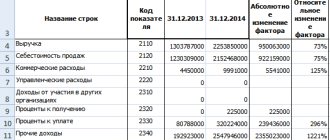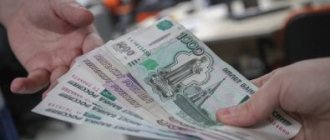Topic 16
Gross output is calculated in current comparable prices, i.e. enterprise prices that are unchanged on a certain date. Using this indicator, the dynamics of total production volume, the dynamics of capital productivity and other indicators of production efficiency are determined.
Work in progress is accounted for at cost. To convert work in progress balances into wholesale prices, two methods are used: I) according to the degree of readiness of work in progress based on the ratio of the labor intensity of work already completed and the labor intensity of the finished product; 2) according to coefficients characterizing the ratio of the cost of finished products in wholesale prices and the actual cost of the same products.
What is included in gross output
Gross output is an indicator that characterizes the total volume of production of individual associations, industries, enterprises, and the national economy as a whole in monetary terms.
The gross output indicator is calculated both in current prices and in comparable prices in the following sectors of production: industry, construction, agriculture, communications, transport and trade, logistics and many others. If we take a separate industrial enterprise, then the gross output is a useful result of production activity, which appears in the form of products or work of an industrial nature, and the gross output of a particular industry is the result of the production activity of the industry for a certain reporting period.
Gross output includes:
- the cost of finished products that were manufactured during a certain reporting period in different workshops (main and auxiliary);
- the cost of semi-finished products of their manufacture, as well as products of auxiliary and ancillary workshops;
- the cost of industrial work performed on orders (this may include major repairs or modernization of equipment and vehicles used by the enterprise);
- change in balances (cost of increase or decrease) of semi-finished products of own production and products of auxiliary workshops.
In enterprises where the production cycle is long, the gross output necessarily takes into account changes in the balance of work in progress.
For the association as a whole, the volume of gross output includes the cost of products manufactured by all production units (regardless of their location), which are intended for sale both outside the association and to independent enterprises subordinate to the association, and the cost of products manufactured by independent enterprises subordinate to the association for sale . In this case, the volume of gross output for the association is determined without taking into account internal turnover, which means without products that are consumed within the association. In industry, gross output is used as a statistical indicator (calculation and reporting).
Gross profit formula for calculating the balance sheet
The second method focuses on the characteristics of changes in the net profit indicator by reporting periods (years or other established frameworks). Numerical data is considered in different sequences to achieve maximum forecasting performance. The following methods can be used: exponential, logarithmic, linear and other methods of working with numbers.
It is necessary to determine the estimated trade markup for each group of goods: For group 1, the estimated trade markup will be: RN = TN / (100 + TN); 39% / (100 + 39) = 28.057%. For goods of group 2: RN = TN / (100 + TN); 26% / (100 + 26) = 20.635%. Gross income (the amount of realized trade margin) will be equal to: (16,800 rubles x 28.057% + 33,200 rubles x 20.635%) / 100 = 11,564 rubles. In the company's accounting, it is necessary to register the following entries: Debit 50 Credit 90-1 – 50,000 rubles. – revenue from the sale of goods is reflected; Debit 90-3 Credit 68 – 7627 rub. – the amount of VAT is reflected; Debit 90-2 Credit 42 (reversal) – 11,564 rubles. – the amount of trade margin related to goods sold is written off; Debit 90-2 Credit 41 – 50,000 rub. – the sales value of goods sold is written off; Debit 90-2 Credit 44 – 3000 rub. – sales expenses are written off; Debit 90-9 Credit 99 – 937 rub. (50,000 rub. – 7,627 rub. – (–11,564 rub.) – 50,000 rub. – 3,000 rub.) – profit from the sale.
What is the difference between profit and gross profit?
From the previous section, you may have noticed that gross profit is a fairly general metric. Of course, gross profit, to a greater extent than, for example, revenue, shows the actual financial result. But it should be taken into account that in addition to the cost of production, many associated costs arise during the sale of products.
Therefore, the concept of “Profit” implies the subtraction of commercial and administrative expenses from revenue in addition to cost. Then we get a value that in accounting is called “profit before tax.”
How to find the value of gross output
2. Based on the financial statements, we find the value of work in progress balances at the beginning and end of the analyzed period. In the Balance Sheet, these figures are entered in lines 130 “Construction in progress” and 213 “Costs in work in progress”. We determine on line 214 of the Balance Sheet “Finished products and goods for resale” the cost of the balances of finished products at the beginning and end of the reporting period.
3. We calculate the gross turnover of products produced by all departments for the period (VO). To the sum of the balances of finished products and work in progress at the end of the period, we add the cost of goods sold and subtract the sum of the balances of finished products and work in progress at the beginning of the period. The calculation algorithm follows from the formula for calculating the balance of active accounts at the end of the period: Balance at the beginning + Income for the period - Expense for the period = Balance at the end of the period.
Commercial products
Sgpn, (8-4) where Sop is the cost of products shipped in the reporting period, rubles; C TP - cost of marketable products produced in this period, rubles; Сгпн, Сгпк - balances of marketable products, respectively, at the beginning and end of the reporting period (at cost), rub. This formula is used for calculation. Based on external accounting reports, only the cost of marketable products produced since the beginning of the reporting year can be calculated. Balances of finished products are determined according to Form 1 “Balance Sheet” at the beginning and end of the period, according to line 215 “Finished products and goods for resale” (balances in warehouse). It should be noted that the assessment of the volume of marketable products produced by the enterprise is approximate. The reason is that line 215 of Form 1 takes into account the balance of “goods for resale” in the total amount. If the enterprise is engaged, in addition to production, also in trading activities, these balances exist. For the accuracy of the calculations, they must be excluded. However, this cannot be done using external accounting data. After calculating the cost of commercial products, you can make an approximate estimate of it in selling prices (this is one of the traditional tasks of analysis). An accurate assessment is impossible in this case, since in Form 1 the balances of finished products (line 215) are taken into account only at cost. For this purpose, the coefficient for converting production costs into selling prices (excluding VAT) is calculated: Kp = Vrp/Srp, (8-5) where Vrp is revenue (net) in Form 2 (line 010), rub; CRP - cost of goods sold, rub. Then the approximate volume of marketable products in selling prices (excluding VAT) in the reporting period can be calculated as: TP=Kp*Stp • (8.6) By analogy, other indicators can be recalculated in selling prices. Gross output is the total number of products (works, services) that were in production during the reporting period. At the same time, the degree of their readiness does not matter: both fully manufactured products and work in progress are taken into account in the gross output. The cost of commercial and gross output is related by the following relationship: Svp = Stp + Snzpk
Snzpn, (8-7) where Svp is the cost of gross output of the reporting period, rubles; Snzpn, Snzpk - balances of work in progress (incompletely manufactured products), respectively, at the beginning and end of the reporting period (at cost), rub. This formula is used for calculation.
Gross output
Sold products characterize the cost of the volume of products that entered the market in a given period and are payable by consumers. Sold products differ from commercial products by the balance of finished products in the warehouse. The volume of products sold (RP) according to the plan is determined by the formula
Thus, the gross output of an enterprise is the total volume of products in value terms produced during the reporting period by all workshops, minus intra-factory turnover. This means that the size of the enterprise's gross output is equal to the difference between gross turnover and intra-factory turnover.
Interesting to read: When Changing a Passport Do I Need to Change a Foreign Passport?
How to calculate gross profit (calculation formula)
Gross profit is one of the main indicators characterizing the results of a company’s economic activities. Calculating gross profit - the formula is presented in our article - allows you to highlight promising areas of business activity and redistribute financial flows to obtain a more effective result.
Gross profit is one of the intermediate types of profit shown in the statement of financial results (clause 23 of PBU 4/99, approved by order of the Ministry of Finance of the Russian Federation dated July 6, 2021 No. 43n). Accordingly, it is determined according to accounting data and represents revenue from the main type (types) of activity, reduced by the cost of sales.
Reflection of gross profit in reporting
As previously mentioned, gross profit is displayed in the financial results report, the form of which was approved by Order of the Ministry of Finance dated July 2, 2010 No. 66n, namely in line 2100.
The indicators “Revenue” and “Cost of sales” are reflected in lines 2110 and 2120, respectively.
Thus, gross profit in the report is formed according to the formula:
The amount of gross profit can be either positive or negative. In the second case, the indicator means a loss and is entered in line 2100 in parentheses without the minus sign.
The cost price must also be indicated in parentheses (the minus sign is not used).
The article “Filling out Form 2 of the balance sheet (sample)” will introduce you to a description and decoding of all the lines of the statement of financial results.
Let's take a closer look at what data is used to form the amount of revenue and cost.
What does revenue come from?
Line 2110 includes data on income from ordinary activities, the definition of which is given in paragraphs. 5, 12 PBU 9/99. Let us remind you that this indicator is entered minus VAT amounts. This is indicated to us by approx. 5 of Appendix No. 1 to Order of the Ministry of Finance dated July 2, 2010 No. 66n, as well as the list of receipts that are not recognized as income of the enterprise, published in paragraph 3 of PBU 9/99.
Revenue is accounted for in account 90.1 separately for each type of activity. The amounts of VAT and excise taxes are displayed on accounts 90.3 and 90.4, respectively. Graphically, the formula for calculating the “Revenue” item can be presented as follows:
What is the cost formed from?
Line 2120 is formed based on data on expenses for ordinary activities described in paragraph 5 of PBU 10/99.
According to the instructions for using the Chart of Accounts, the cost of products, goods, and services is accounted for in account 90.2. Write-off of cost is recorded by posting:
Dt 90.2 Kt 20, 23, 29, 40, 41, 43, etc.
It should be taken into account that commercial and administrative costs are also accumulated in account 90.2. And they, as we know, do not form the line indicator 2120. These expense items are drawn up in correspondence with accounts 26 and 44.
How to correctly calculate revenue using the formula
A large number of entrepreneurs, especially among beginners, often cannot accurately calculate their own profit that their enterprise brings them. The point is not a mathematical failure, but the fact that many choose incorrect formulas for calculations, as well as incorrect planning of their expenses.
- Revenue that was received from the basic activity of the organization, that is, from the sale of products, performance of work and provision of services.
- Revenue received as a result of investment transactions (for example, the sale of non-current assets, transactions involving securities, etc.)
- Revenue generated as a result of the financial activities of the enterprise.
Sales revenue - formula and concepts
The calculation formula may include product volume and discounts. Sometimes there is a guarantee of demand for products. Then the amounts from buyers are taken into account by direct counting, implying a specific amount of consumer demand. That is, the production and sales process are connected by a certain amount.
Return on sales is usually calculated by dividing operating profit by sales volume. Operating profit is that profit expressed before taxes. This type of profitability ratio shows whether the company's pricing policy is correct.
Accountant's Directory
The gross output of the agro-industrial complex represents the value of the total product created as a result of the production of agricultural raw materials, its processing and bringing it to its final consumer form. In the agricultural sector of the agro-industrial complex, gross output is understood as the value of products obtained as a result of growing plants, animals and their economic use for a certain period of time (day, month, quarter, season, calendar year, etc.).
1.the cost of means of production consumed in the production process during a given period (year)
, that is, from the value transferred to the product, created by past labor (the cost of material production costs, that is, the cost of seeds, feed, fuel and other material resources spent in the production process);
Enterprise products: concept, cost indicators, competitiveness
the cost of seeds, feed, fuel and other materials used in the production process;
2. newly created value, or net agricultural products.
Net agricultural output is defined as the difference between the gross output of a given period (year) and the cost of material production costs in the production process of these products. It is part of the country's national income.
Based on the nature of use, gross output is divided into two parts:
1. commodity (that part of the gross output that is sold by agricultural organizations to the outside (sold, given in exchange, for services, etc.));
2. non-commodity (used for on-farm needs, and in personal subsidiary plots of workers and employees —
also for personal consumption (food)).
The main types are considered to be those products for which production is organized and operates (grain, flax products, sugar beets, potatoes, vegetables, milk, live weight gain of cattle, pigs, eggs). They play a leading role.
Many crops and groups of animals simultaneously produce two or more types of products, which are called conjugate
.
Conjugate types are those products that can be obtained in parallel with the main ones. When growing flax, the main product is flax straw, followed by flax
seeds.
In dairy production, milk is
the main product, and the offspring of animals
is
a secondary product.
Products that are obtained simultaneously with the main products and which are not the purpose of production are called by-products.
.In crop farming, by-products include straw, green fodder, tops, etc., and in livestock farming - manure, bird droppings, fluff, feathers, etc.
Gross output of the auxiliary sector is the cost of the entire volume of work and services intended for the normal functioning of the agricultural sector of the agro-industrial complex during a certain period.
Gross output of the processing sector is the total value of all types of final products produced by processing organizations of the agro-industrial complex during a certain period of time.
Gross output of the trade and sales sector represents the cost of work performed and services for the preparation, delivery, sale of agricultural products and food and consumer goods created in the agro-industrial complex system.
Add to favoritesSend by email Gross profit is one of the main indicators characterizing the results of a company’s economic activities. Calculating gross profit - the formula is presented in our article - allows you to highlight promising areas of business activity and redistribute financial flows to obtain a more effective result. What does "gross profit" mean? Gross profit is the difference between revenue and costs. How to calculate gross profit (by what formula)? What items are used in the gross profit formula? Results What does the concept of “gross profit” mean? Gross profit is one of the intermediate types of profit shown in the statement of financial results (clause 23 of PBU 4/99, approved by order of the Ministry of Finance of the Russian Federation dated July 6, 1999 No. 43n).
Gross output formula for calculating the balance sheet
To quickly count points and the number of transactions, we use account monitoring. : the trader made 100 trades, the currency is GBPJPY, the spread is 7 points, the working fixed lot is 1, the swap amount is approximately -$50 (for all trades), there were profitable and unprofitable trades, as a result the trader earned 100 points. we get: income $8050, net income $950, costs $7050, profit to cost ratio
In this case: TN – trade markup as a percentage. Turnover refers to the total amount of revenue. : At Biryusa LLC, the balance of goods at sales value (balance on account 41) as of July 1 amounted to 12,500 rubles. The trading margin on the balance of goods as of July 1 (account balance 42) is 3,100 rubles. In July, products were received at the purchase price excluding VAT in the amount of 37,000 rubles. According to the order of the head of the organization, the accountant must charge a trade margin of 35 percent on all goods. Its amount for goods received in July was 12,950 rubles. (RUB 37,000 x 35%). The company earned 51,000 rubles from sales in July (including VAT - 7,780 rubles). Selling expenses – 5000 rub.
Interesting read: VAT on payment or shipment 2021
Calculation of gross, marketable and sold products
Because the price per unit of work in progress has not been determined, then we will consider the price of work in progress to be 500 rubles per unit, the work in progress is a 1st grade product., then work in progress at the beginning of the year in the amount of 1000 x 500 = 500,000 rubles, at the end of the year 2021 x 500= 1,000,000 rubles.
Fixed assets are the material basis of production. They include active and passive fixed assets: the first includes material objects that take a direct part in the production process (machines, machines, tools); and to the second - objects that provide normal production conditions, but are not directly involved in it (industrial buildings, transfer devices, etc.).
Formula for calculating cost of goods sold
To illustrate the application of the methodology for calculating the cost of products sold, let’s consider a specific example. The company Posuda LLC produces various types of tableware. It is required to calculate the cost of production for July, when it is known that 70 saucepans and 50 kettles were produced, and 52 saucepans and 35 kettles were sold.
- assessment of changes in the cost value and its relation to planned indicators;
- assessment of the validity of planned cost values;
- identification of factors influencing the formation of the indicator and its changes, as well as deviations of the final value from the plan;
- identification of lost opportunities and unused reserves;
Determining the value of the gross output of the ORGANIZATION
Types of products Gross harvest / output, c Comparable price for 1 c, rub. 1994 Cost of gross output in comparable prices, thousand rubles. 2021 2021 2021 2021 2021 2021 PLANT CULTIVATION Cereals and legumes, c 10.9 Corn, c 27.2 Soybeans, c 43.6 Sugar beets, c 5.6 Flax, c 35 .2 Tobacco, c 59.4 Sunflower, c 26.8 Potatoes, c 31.5 Open ground vegetables, c 48.5 Protected ground vegetables, c 72.3 Melons, c 31.2 Fruits, c 81.8 Grapes , c 96.4 Tea, c 380.7 Forage root crops, c 3.3 Perennial grasses for hay, c 3.7 Perennial grasses for green mass, c 2.0 Annual grasses for hay, c 4.3 Annual grasses for green weight, c 2.0 Corn for silage and green fodder, c 1.1 Ensilage, c 1.1 Haying, c 1.2 Total for crop production — — — — ANIMAL HUSBANDRY Milk 29.6 Live weight gain of cattle silent. herd 113.8 Live weight gain of beef cattle 113.8 Live weight gain of pigs 190.5 Live weight gain of sheep 97.0 Wool 140.8 Eggs 90.8 Live weight gain of poultry 192.6 Honey 80.6 Fish 38.1 Total for livestock farming — — — — TOTAL — — — —
- Find, according to the financial statements (form 5 Explanations to the balance sheet and profit and loss statement), the value of work in progress balances at the beginning and end of the analyzed period. In f. 5, these figures are entered in lines 5240 “Construction in progress” and 5403 “Costs in work in progress”. Determine line 5404 f. 5 “Finished products and goods for resale” the cost of finished product balances at the beginning and end of the reporting period.
21 Dec 2021 uristland 960
Share this post
- Related Posts
- Bailiffs Perm region alimony
- Find alimony debtor in Surgut, Tyumen region
- Judicial practice in civil cases for the collection of alimony after 18 years in the Republic of Kazakhstan
- Judicial practice on the collection of alimony for minor children from a resident of Germany
Cost of gross output in the balance sheet: line
According to the norms of PBU No. 34n dated July 29, 1998 (as amended on April 11, 2018), financial statements must include reliable information, and the balance sheet must include asset balances in accounting accounts. Since MPZs are involved in the creation of products, the balances of raw materials and supplies, as well as unsold finished products, semi-finished products and work-in-progress products are taken into account in the appropriate accounts (20, 21, 40, 43, 45) and appear in the second section of the balance sheet “Working capital” in line 1210 “Inventories”, which combines all information about the availability of material assets of the enterprise at a certain moment. Is it possible to see the cost of gross output in the balance sheet?
It is difficult to establish the size of gross output in the balance sheet - there is no line for this indicator. However, based on the principles of equivalence of assets and liabilities of the balance sheet, it can be determined by examining all the costs incurred in the production of products: expenses accompanying the production process, wages, depreciation, purchase of raw materials, etc. All listed costs sum up the cost of gross production, which is written off after the sale of products, and the remaining products are included in the balance sheet, forming line 1210.
But the financial statements also contain a “Statement of Financial Results”, where line 2120 indicates the cost of sales, which can be used in the analysis of the company’s condition as an indicator of marketable products, adding to this value the difference in indicators of work in progress and the presence of semi-finished products, as well as the volume of products , consumed for own needs.
For example, based on the data in the above example, we can say that line 1210 of the balance sheet will reflect the cost of the balances of semi-finished products (8 million rubles) and “work in progress” - 38 million rubles. in the total volume of available inventories, and sales indicators in the amount of 900, 30 and 11 million rubles. will generate the cost of sales according to the “Income Statement”.









